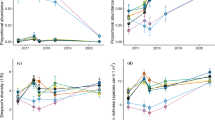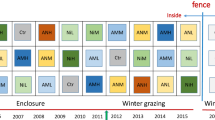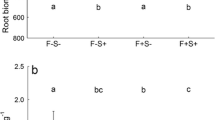Abstract
Fertilization of grasslands commonly leads to species loss and a dramatic shift in species composition, but the mechanisms underlying this pattern remain unclear. One oft-stated hypothesis is that fertilization increases competition for light and/or reduces spatial heterogeneity of resources, thereby reducing the niche dimensionality for species to coexist. Here, we summarize results from two long-term field experiments showing that the negative effects of fertilization on grassland species richness are greater in the presence of species with a spreading clonal growth form, particularly species that are tall (hereafter ‘tall clonals’). The interactive effect of fertilization and the presence of clonal species on the loss of species richness is associated with: (1) a pronounced increase in the relative abundance of tall clonals following fertilization, and (2) a greater reduction in mean light levels and reduced spatial heterogeneity in light when tall clonal species are present. We hypothesize that tall clonals gain a competitive advantage following fertilization as a result of two important traits related to clonality: (1) the ability to translocate resources between ramets in high to those in low resource patches and (2) the ability to spread vegetatively, especially under conditions where low-light levels limit recruitment from seeds. We suggest that efforts to mitigate the negative effects of nutrient enrichment on grassland diversity may be enhanced by controlling dominance by tall clonal grasses and forbs, and that these results have important implications for management efforts to maintain and enhance plant diversity in grasslands.




Similar content being viewed by others
References
Baer SG, Blair JM, Collins SL (2016) Environmental heterogeneity has a weak effect on diversity during community assembly in tallgrass prairie. Ecol Monogr 86:94–106
Bullock JM, J Aronson AC Newton, RF Pywell, JM Rey-Benayas (2011) Restoration of ecosystem services and biodiversity: conflicts and opportunities. TREE 26:541–549
Clark CM, Tilman D (2008) Loss of plant species after chronic low-level nitrogen deposition to prairie grasslands. Nature 451:712–715
Clark CM, Cleland EE, Collins SL, Fargione JE, Gough L, Gross KL, Pennings SC, Suding KN, Grace JB (2007) Environmental and plant community determinants of species loss following nitrogen enrichment. Ecol Letters 10:596–607
Cleland EE, Harpole WS (2010) Nitrogen enrichment and plant communities. Ann New York Acad Sci 1195:46–61
Cleland EE Clark CM, Collins SL Fargione JE, Gough L Gross KL, Milchunas DG, Pennings SC, Bowman WD, Burke IC, Lauenroth WD, Robertson GP, Simpson JC, Tilman D, and Suding KN (2008) Species responses to nitrogen fertilization in herbaceous plant communities, and associated species traits (Data Publication). Ecology 89:1175
Collins B, Wein G (1998) Soil heterogeneity effects on canopy structure and composition during early succession. Pl Ecol 138:217–230
Cornelissen JHC, Song YB, Yum FH, Dong D (2014) Plant traits and ecosystem effects of clonality: a new research agenda. Ann Bot (Oxford) 114:369–376
Dickson TL, Foster BL (2011) Fertilization decreases plant biodiversity even when light is not limiting. Ecol Letters 14:380–388
Dickson TL, Gross KL (2013) Plant community responses to long-term fertilization: Changes in functional group abundance drive changes in species richness. Oecologia 173:1513–1520
Dickson TL, Mittelbach GG, Reynolds HL, Gross KL (2014) Height and clonality traits determine plant community responses to fertilization. Ecology 95:2443–2452
DiTommaso A, Aarssen LW (1989) Resource manipulations in natural vegetation: a review. Vegetatio 84:9–29
Dupré C, Diekmann M (2001) Differences in species richness and life-history traits between grazed and abandoned grasslands in southern Sweden. Ecography 24:275–286
Dybzinski R, Tilman D (2007) Resource use patterns predict long-term outcomes of plant competition for nutrients and light. Amer Naturalist 170:305–318
Eilts A, Mittelbach GG, Reynolds HL, Gross KL (2011) Resource heterogeneity, soil fertility and species diversity: Effects of clonal species on plant communities. Amer Naturalist 177:574–588
Foster BL, Gross KL (1998) Species richness in a successional grassland: effects of nitrogen enrichment and plant litter. Ecology 79:2593–2602
Goldberg DE, Werner PA (1983) Equivalence of competitors in plant communities: a null hypothesis and a field experimental approach. Amer J Bot 70:1098–1104
Gough L, Osenberg CW, Gross KL, Collins SL (2000) Fertilization effects on species density, richness and primary productivity in herbaceous plant communities. Oikos 89:428–439
Gough L, Gross KL, Cleland EE, Clark CM, Collins SM, Fargione JE, Pennings SC, Suding KN (2012) Incorporating clonal growth form clarifies the role of plant height in response to nitrogen addition. Oecologia 169:1053–1062
Grace JB, Anderson TM, Seabloom EW, Borer ET, Adler PB, Harpole WS, Hautier Y, Hillebrand H, Lind EM, Pärtel M, Bakker JD, Buckley YM, Crawley MJ, Damschen EI, Davies KF, Fay PA, Firn J, Grunger DS, Hector A, Knops JM, MacDougall AS, Melbourne BA, Morgan JW, Orrock JL, Prober SM, Smith MD (2016) Integrative modeling reveals mechanisms linking productivity and plant species richness. Nature 529:390–393
Gross KL, Mittelbach GG, Reynolds HL (2005) Grassland invisibility and diversity: Responses to nutrients, seed input and disturbance. Ecology 86:476–486
Harpole WS, Tilman D (2007) Grassland species loss resulting from reduced niche dimension. Nature 446:791–793
Hautier Y, Niklaus PA, Hector A (2009) Competition for light causes plant biodiversity loss after eutrophication. Science 324:636–63
Klimeš L, Klimešová J, Hendriks R, van Groenendael J (1997) Clonal plant architecture: A comparative analysis of form and function. in H de Kroon and J van Groendahl (eds) Ecology and evolution of clonal plants. Backhuys Publ, Leiden, The Netherlands, pp 1–29
Liira J, Ingerpuu N, Kalamees R, Moora M, Pärtel M, Püssa K, Roosaluste E, Saar L, Tamme R, Zobel K, Zobel M (2012) Grassland diversity under changing productivity and the underlying mechanisms – results of a 10-yr experiment. J Veg Sci 23:919–930
Liu F, Liu J, Dong M (2016) Ecological consequences of clonal integration in plants. Frontiers Pl Sci 7:770
Lowe, S, Browne, M, Boudelas, S, De Poorter, M. (2000) 100 of the World’s Worst Invasive Alien Species: A Selection from the Global Invasive Species Database. Published by The Invasive Species Specialists Group (ISSG), a specialist group of the Species Survival Commission (SSC) of the World Conservation Union (IUCN), 12 pp
McGregor RL, Barkley TM, Brooks RE, Schofield EK (1986) Flora of the Great Plains. University Press of Kansas, Lawrence, Kansas, USA
Moles AT, Westoby M (2002) Seed addition experiments are more likely to increase recruitment in larger-seeded species. Oikos 99:241–248
Moles AT, Westoby M (2004) Seedling survival and seed size: a synthesis of the literature. J Ecol 92:372–383
Newman EI (1973) Competition and diversity in herbaceous vegetation. Nature 244:310
Pykälä J (2004) Cattle grazing increases plant species richness of most species trait groups in mesic semi-natural grasslands. Pl Ecol 175:217–226
Rajaniemi TK (2002) Why does fertilization reduce plant species diversity? Testing three competition-based hypotheses. J Ecol 90:316–324
Reynolds HL, Mittelbach GG, Darcy-Hall TL, Houseman GR, Gross KL (2007) No effect of varying soil resource heterogeneity on plant species richness in a low fertility grassland. J Ecol 95:723–733
Silvertown J, Poulton P, Johnston E, Edwards G, Heard M, Biss PM (2006) The Park Grass Experiment 1856–2006: Its contribution to ecology. J Ecol 94:801–814
Song Y-B, Yu F-H, Keser LH, Dawson W, Fischer M, Dong M, Kleunen M (2013) United we stand, divided we fall: A meta-analysis of experiments on clonal integration and its relationship to invasiveness. Oecologia 171:317–327.
Stevens MHH, Carson WP (2002) Resource quantity, not resource heterogeneity, maintains plant diversity. Ecol Letters 5:420–426
Stevens CJ, Dice NB, Mountford LO, Gowling DJ (2004) Impact of nitrogen deposition on the species richness of grasslands. Science 303:1876–1879
Suding KN, Collins SL, Gough L, Clark C, Cleland EE, Gross KL, Milchunas DG, Pennings S (2005) Functional- and abundance-based mechanisms explain diversity loss due to N fertilization. Proc Natl Acad Sci USA 102:4387–4392
Tilman D (1982) Resource competition and Community Structure. Princeton Monographs, Princeton University Press, Princeton, NJ
Tilman D (1988) Plant strategies and the dynamics and structure of plant communities. Princeton University Press, Princeton, NJ
Tolvanen A, Siikamaki P, Mutikanainen P (2004) Population biology of clonal plants: forward to the Proceedings of the 7th Clonal Plant Workshop. Evol Ecol 18:403–408
Turnbull LA, Crawley MJ, Rees M (2000). Are plant populations seed-limited? A review of seed sowing experiments. Oikos 88:225–238
Vojtkó AE, Freitag M, Bricca A, Martello F, Moreno Compañ J, Küttim M, Kun R, de Bello F, Klimešová J, Götzenberger L (2017) Clonal vs leaf-height-seed (LHS) traits: Which are filtered more strongly across habitats? Folia Geobot (in press)
Werling BP, Dickson TL Issacs R, Gaines H, Gratton C, Gross KL, Liere H, Malmstrom CM, Meehan TN, Ruan L, Robertson BA, Robertson GP, Schmidt GP, Schrotenboer AC, Teal TK, Wilson JK, Landis DA (2014) Perennial grasslands enhance biodiversity and multiple ecosystem services in bioenergy landscapes Proc Natl Acad Sci USA 111:1652–1657
Westoby M (1998) A leaf-height-seed (LHS) plant ecology strategy scheme. Pl & Soil 199:213–227
Zhang J-Y, Wu, Y-X (2014) Changes in diversity and importance of clonal plants during sand dune succession in northeastern China. Ecol Res 29:393–399
Acknowledgements
We appreciate the opportunity to contribute to this Special Feature prepared in conjunction with the CLONE 2015 meetings in Trebon, Czech Republic. Special thanks to Jitka Klimešová and Tomáš Herben for their efforts in organizing the conference and overseeing the Special Feature. The work summarized here is the product of a long collaboration between KLG, GGM and many former postdocs and graduate students, particularly Heather Reynolds (University of Indiana) who was a co-PI on several of the grants that funded this work. We gratefully acknowledge Carol Baker for her expert help in the lab and the field, and thank Tim Dickson, Karen Stahlheber Nikolakis and two anonymous reviewers for comments on earlier versions of the manuscript. The US National Science Foundation, Andrew Mellon Foundation, and Michigan AgBio Research of Michigan State University provided funding for this research. The research reported here was done in compliance with the laws of the United States of America. This is KBS contribution number 1986.
Author information
Authors and Affiliations
Corresponding author
Rights and permissions
About this article
Cite this article
Gross, K.L., Mittelbach, G.G. Negative effects of fertilization on grassland species richness are stronger when tall clonal species are present. Folia Geobot 52, 401–409 (2017). https://doi.org/10.1007/s12224-017-9300-5
Received:
Accepted:
Published:
Issue Date:
DOI: https://doi.org/10.1007/s12224-017-9300-5




